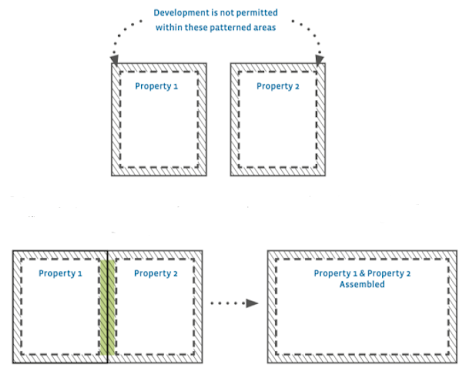Benefits of a Land Assembly
Land assemblies are a common topic of conversation when we are working with owners of development land. We’ve found that there is limited information out there about why they occur and how they can benefit a land owner.
The below illustrates what a land assembly is, why they happen, and (most importantly) 4 ways an assembly can increase the value of a property with future development potential. We have also outlined tips on applying this information to your own real estate strategy.
What is a land assembly?
Land assembly is when multiple properties are combined in order to create a single development site. Land assembly is most common in areas where individual properties are too small to be developed on their own.
A land assembly can be formed in multiple ways:
- An investor or developer purchases multiple adjacent properties over a period of time (sometimes years) to form a single development site
- Multiple neighbouring property owners come together to sell their properties at the same time as a single development site
Click here to learn more about what a land assembly is.
Benefits of a Land Assembly
Land assembly increases the price that a landowner can receive for their property. Let’s have a look at the four main reasons why:
1. Land Assembly Reduces Risk
For a buyer, a land assembly has lower risk, especially when it comes in the form of a bulk purchase of multiple properties at the same time. That being said, when the buyer has to purchase one property at a time over many years, it creates uncertainty regarding how long the buyer will have to pay holding costs on individual properties before they acquire the whole development site (or at least enough to start development). To compensate for this risk, buyers pay less for individual properties when they are sold one at a time.
2. Land Assembly Increases Efficiency of Developments
Land assembly often results in larger and more efficient development sites which provide more flexibility for developers to work around property characteristics or development hurdles (ex: new roads, setbacks, odd property shapes, and other requirements). Due to this flexibility, a developer is more likely to be able to optimize a future development’s site plan and achieve full density – an appealing prospect for any development land buyer.
3. Land Assembly Achieves Developable Size
Some properties are too small to develop on their own. The assembly of many adjacent properties can turn a property into a viable development site, making it appealing to a wider range of buyers (including developers and builders) while potentially increasing the property’s value.
4. Land Assembly Increases Developable Land
There is an area along the edge of every property where development is not permitted. This allows for things like sidewalks and yards while also assuring neighbouring buildings are not built too close together. But, if neighbouring properties are assembled and combined, the undevelopable area between the two properties (highlighted in green below) becomes developable. This increases the total developable area where building can occur, as illustrated below:

How to APPLY What You Just Learned
Land assemblies offer great opportunities for property owners, but there are also potential risks. The tips below will guide you on how to apply the information you just learned if/when you choose to sell your property.
I Plan to Sell My Development Property Soon
- Review your neighbourhood’s land use map to identify potential land assembly scenarios with neighbouring properties
- Talk to your neighbours to establish their interest in selling their property with yours as a land assembly
- Contact a Realtor that specializes in selling development land, they can help you understand your property’s land assembly potential further
I Am Not Planning on Selling My Development Property Anytime Soon
- Maintain a dialogue with your neighbours so that if one was to sell in the future you will be in the loop and you could sell together; maximizing the sale price of all properties involved
- Stay informed about development activity in your neighbourhood, paying special attention to any development application notices you receive in the mail to avoid getting left out of a neighbouring assembly
Caution: The main risk for a land owner is holding out too long. In the same way that assemblies create efficiencies, holding out so long that the neighbouring properties assemble and develop without you can leave you stuck with an inefficient development site or a property that is just too small to develop on its own. This can result in a significant loss of property value.
In most circumstances, developers can pay more for a land assembly than a single property so it pays to take the time to understand the assembly potential of your property. If you would like to learn more about property assemblies or have any questions about the assembly potential of your property, don’t hesitate to contact us today.
